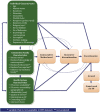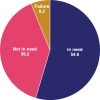Factors that affect the discontinuation of family planning methods in Myanmar: analysis of the 2015-16 Myanmar Demographic and Health Survey
- PMID: 33292698
- PMCID: PMC7653857
- DOI: 10.1186/s40834-020-00126-5
Factors that affect the discontinuation of family planning methods in Myanmar: analysis of the 2015-16 Myanmar Demographic and Health Survey
Abstract
Background: Access to family planning contributes up to a 44% reduction in maternal deaths. Since the majority of unplanned pregnancies and abortions occur in women who were either not using contraception or not using it consistently, greater access to contraception and more consistent use of contraception are crucial in the reduction of unplanned pregnancies and abortions. This study aims to determine which types of contraceptives are most often discontinued, the reasons for discontinuation, and the factors that influence contraceptive discontinuation for women in Myanmar.
Methods: This study is a secondary data analysis of calendar data from the 2015-16 Myanmar Demographic Health Survey. The dependent variable is discontinuation of contraception within 12 months among episodes of contraceptive use in the 5 years before the survey among women age 15-49. Multivariable logistic regression was used to identify the predictors of contraceptive discontinuation.
Results: The 12-month discontinuation rate for all contraceptive methods was 39%. The discontinuation rates for short-term methods were remarkably high (43% for pills and 42% for injectables), while the rate for long-term methods was very low (7% for intrauterine devices and 0.2% for implants). Discontinuation while still in need of contraception was high (55%) although 28% of those women switched to other modern methods. Multivariable logistic regression showed the factors associated with contraceptive discontinuation were a woman's age, location (state/region), wealth, and number of births within the past 5 years.
Conclusions: The high rate of discontinuation while in need is very alarming given goals to reduce the unmet need for family planning in Myanmar. Family planning programs must ensure timely, informed method-switching by women who discontinue contraception, especially among women for whom discontinuation is the highest (age 45-49, middle and richest wealth quintile, regions where high discontinuation and multiparity); increase the availability of long-term contraceptive methods, and improve counseling that ensures clients' informed and voluntary choice of family planning services.
Keywords: Contraceptive; Discontinuation; Family planning; Unmet need.
Conflict of interest statement
The authors declare that they have no competing interests.
Figures
References
-
- New JR, Cahill N, Stover J, Gupta YP, Alkema L. Levels and trends in contraceptive prevalence, unmet need, and demand for family planning for 29 states and union territories in India: a modelling study using the family planning estimation tool. Lancet Glob Health. 2017;5:e350–e358. doi: 10.1016/S2214-109X(17)30033-5. - DOI - PubMed
-
- Kaye K, Gootman JA, Ng AS, Finley C. The benefits of birth control in America: getting the facts straight. The National Campaign to prevent teen and unplanned Pregnanc. Washington, DC: The National Campaign to Prevent Teen and Unplanned Pregnancy; 2014.
-
- WHO Global Health Observatory data repository | By category | Maternal mortality - Data by country. In: WHO. http://apps.who.int/gho/data/node.main.15. Accessed 12 Aug 2018.
-
- Department of Population; Ministry of Labour Immigration; Ministry of Health and Sports . The 2014 Myanmar population and housing census. Naypyitaw: Republic of Union of Myanmar; 2015.
LinkOut - more resources
Full Text Sources
Miscellaneous



